Get curious and meet your customers at the intersection
Spend time discovering your customers’ hopes, fears and values, and viewing the world through their eyes.

A Harvard Business Review study published last year, Are You Solving the Right Problems?, found 85 per cent of 106 C-suite executives in 17 countries strongly agreed or agreed their organisations were bad at diagnosing problems, while 87 per cent strongly agreed or agreed this flaw carried significant costs.
In Australia, the performance of retail group Myer continues a downward trend. Under pressure from the much-anticipated arrival of Amazon, Myer launched an online marketplace of local and international brands, The Myer Market. Myer was responding to a business problem, but the offer does not appear to address existing customer problems, evident in online customer reviews of Myer.com.au.
While it is obviously vital for businesses to stand out and stay ahead of their competition, this is becoming increasingly harder to do, especially for larger organisations such as Myer, which may not be as agile as a smaller start-up or the likes of Amazon.
Many are investing time, effort, money and resources coming up with innovative ideas and solutions for problems customers don’t have.
Organisations are under incredible pressure to produce quick results, with leaders chasing immediate results. When a business problem arises, their reaction is to jump in to finding a solution without checking if the problem they are setting out to solve is a commercial one that will return the best investment.
The best commercial opportunities arise at the intersection of a business problem and a customer problem. Getting curious about this is the key to workplace innovation. Curiosity arises when there is a gap between what someone knows, or think they know, and what they want to know. That is, individuals are intrinsically motivated to seek information. It is a mindset that can be activated. Curiosity is the fuel for inquiry, learning and discovery.
When leaders are curious, they look at how customer needs will change in the coming few years. They see how all of the present disruptions will feed into one another. They think about the biggest problems or pressures their organisation is likely to face in the next few years.
In today’s business world, leaders need to spend less time in the office and more time walking in the shoes of their customer to find clues and collect artefacts that build a whole picture of their customers’ experiences.
It is important to spend time discovering customers’ hopes, fears and values, and viewing the world through their eyes; noticing what delights them and observing their irritations, frustrations and pain points as they interact with the world around them.
When leaders create an environment of curiosity, they also inspire their employees to ask questions, learn, and seek problems and solutions for themselves. When employees are curious, they are open to discovering new things, leading to better insights and platforms for problem finding, and ultimately innovation.
As the need for innovation intensifies, there is an opportunity to leverage curiosity as a competitive advantage. That means creating a culture for curiosity to thrive within organisations now, as well as in the future.
Evette Cordy is an innovation specialist and author of Cultivating Curiosity.


